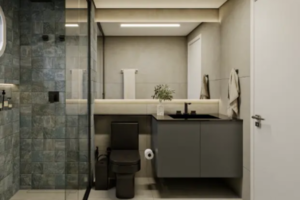Creating a functional and stylish bathroom in a small space can be a challenge, especially when it comes to choosing the right materials for cabinetry. Bathrooms are high-moisture environments, making the selection of moisture-resistant materials essential for preventing damage and maintaining the longevity of the cabinets. This article explores the best moisture-resistant materials for custom cabinets in small bathrooms, how they can help maximize space, and what to consider when selecting the right options for your design.
Understanding Moisture in Bathrooms
Before diving into the materials, it’s important to understand how moisture affects cabinetry. In a bathroom, exposure to steam from showers, water splashes from sinks, and the general humid environment can lead to swelling, warping, and eventual deterioration of non-moisture-resistant materials. Even in small bathrooms, where ventilation may be limited, this can become a significant issue.
The constant cycle of moisture and drying can lead to mould, mildew, and damage over time. This is why investing in materials that are specifically designed to withstand such conditions is essential for the longevity and functionality of custom cabinets.
Ideal Moisture-Resistant Materials for Custom Cabinets
When selecting materials for custom cabinets in small bathrooms, it’s crucial to focus on those that offer high durability and resistance to moisture, without compromising on style. Below are some of the best moisture-resistant materials to consider:
Plywood
Plywood is an excellent option for bathroom cabinets, especially for those who prefer a natural wood aesthetic. Unlike particleboard, which can swell and warp when exposed to moisture, plywood is made by layering sheets of wood veneer, which makes it stronger and more stable. When treated with a waterproof sealant or marine-grade varnish, plywood can provide long-lasting durability, even in the humid environment of a bathroom.
It’s important to choose a high-quality plywood, as lower-grade options may not hold up as well in moist conditions. For custom cabinetry in small bathrooms, plywood is not only a moisture-resistant option but also versatile, allowing for creative designs and efficient use of space.
Medium-Density Fibreboard (MDF)
MDF is a popular material for bathroom cabinetry due to its smooth surface and resistance to warping. While standard MDF is not particularly resistant to moisture, there are moisture-resistant MDF options available that are treated with resins and waxes to improve their durability in damp environments.
Moisture-resistant MDF is cost-effective, easy to work with, and can be painted or laminated to match any bathroom design. It’s a great option for custom cabinets, especially in small bathrooms where you may want a clean, minimalist aesthetic.
Thermofoil
Thermofoil is a synthetic material that is often applied to MDF or particleboard. It’s made from a thin layer of vinyl that is heated and vacuum-sealed onto the cabinet’s surface. Thermofoil cabinets are highly resistant to moisture, easy to clean, and available in a wide variety of colours and finishes, making them a popular choice for small bathrooms.
The glossy finish of thermofoil reflects light, which can help make a small bathroom feel larger and brighter. Additionally, it’s an affordable option compared to solid wood or higher-end materials, while still providing durability in moist conditions.
High-Pressure Laminate (HPL)
High-pressure laminate is another excellent option for bathroom cabinetry. It is created by fusing layers of paper and resin under high heat and pressure, which makes it both durable and moisture-resistant. HPL can be applied over a variety of core materials, including plywood or MDF, making it a versatile choice for custom cabinets.
HPL is resistant to both moisture and scratches, making it a practical option for small bathrooms where space is limited and surfaces are used frequently. It’s also available in a wide range of colours, textures, and patterns, allowing for creative and stylish cabinet designs.
Stainless Steel
For those looking for an ultra-durable, modern material, stainless steel is an exceptional option for bathroom cabinets. Stainless steel is naturally resistant to moisture, rust, and corrosion, making it ideal for high-moisture environments like bathrooms.
While it may not be the first material that comes to mind for cabinetry, stainless steel can create a sleek, contemporary look, particularly in small bathrooms with minimalist or industrial designs. It’s also extremely hygienic and easy to clean, making it a low-maintenance option.
Solid Surface Materials
Solid surface materials, such as Corian, are often used for countertops but can also be used to create custom cabinetry in small bathrooms. These materials are non-porous and resistant to moisture, mould, and bacteria, making them ideal for bathroom environments.
Solid surface materials are available in a wide range of colours and finishes, allowing for a high level of customisation. They can be seamlessly integrated with other bathroom elements, such as sinks and countertops, creating a cohesive, modern look.
Maximise Space in Small Bathrooms with Custom Cabinets
In addition to choosing the right moisture-resistant materials, it’s essential to consider how custom cabinetry can help maximise space in small bathrooms. Limited square footage can be challenging, but with thoughtful design and smart use of materials, you can create storage solutions that are both functional and stylish.
Wall-Mounted Cabinets
Wall-mounted cabinets are a great solution for small bathrooms, as they free up floor space and create the illusion of a larger room. Using moisture-resistant materials such as plywood or high-pressure laminate, you can create sleek, floating cabinets that provide ample storage without overwhelming the space.
Incorporating cabinets with mirrored fronts can also help reflect light and make the bathroom feel more open, while still offering valuable storage for toiletries and bathroom essentials.
Corner Cabinets
Corners are often underutilised in bathroom design, especially in small spaces. Custom corner cabinets made from moisture-resistant materials can provide additional storage without taking up valuable space. These cabinets can be designed to fit snugly into the corner, maximising storage while maintaining a compact footprint.
Vertical Storage Solutions
When space is at a premium, vertical storage is key. Tall, narrow cabinets can be a game-changer in small bathrooms, providing plenty of room for towels, toiletries, and cleaning supplies without encroaching on floor space.
Using moisture-resistant materials such as MDF or thermofoil, you can create custom cabinets that fit perfectly into awkward spaces, such as beside the sink or above the toilet, helping to keep the bathroom organised and clutter-free.
Integrated Shelving
Open shelving can be a stylish and functional addition to small bathrooms. Custom cabinets with integrated shelving can provide extra storage for frequently used items, such as towels or toiletries, while adding a decorative element to the bathroom. By using materials like high-pressure laminate or plywood, you can ensure that these shelves are resistant to moisture and built to last.
Important Considerations When Choosing Cabinet Materials
While moisture resistance is a critical factor in selecting cabinet materials for small bathrooms, there are several other factors to consider to ensure that your custom cabinetry is both functional and visually appealing.
Durability
Bathrooms are high-traffic areas, and cabinets will see frequent use. Choosing materials that are not only moisture-resistant but also durable will ensure that your cabinets can withstand the wear and tear of daily use.
Style
The material you choose should complement the overall style of your bathroom. Whether you’re going for a sleek, modern look with stainless steel or a more traditional feel with plywood, selecting materials that align with your design vision is essential.
Maintenance
Some materials, like stainless steel and thermofoil, are incredibly low-maintenance and easy to clean. Others, such as plywood, may require periodic resealing to maintain their moisture resistance. Consider how much time and effort you’re willing to put into maintaining your cabinets when choosing a material.
Budget
Cost is always a factor when selecting materials for any home project. While some materials, like stainless steel or solid surface, may be more expensive, there are more affordable moisture-resistant options available, such as MDF and high-pressure laminate, that still offer durability and style.
Conclusion
Choosing the right moisture-resistant materials for custom cabinets in small bathrooms is essential for creating a functional and stylish space that will stand the test of time. From plywood and MDF to stainless steel and high-pressure laminate, there are plenty of options available to suit your budget and design preferences. By selecting durable, moisture-resistant materials and incorporating smart storage solutions, you can maximise space in even the smallest of bathrooms while ensuring that your cabinets remain in excellent condition for years to come.
FAQs
What is the best material for bathroom cabinets?
The best material depends on your budget, style preferences, and specific bathroom needs. Plywood, moisture-resistant MDF, thermofoil, and high-pressure laminate are all excellent options due to their durability and moisture resistance.
How do I protect my bathroom cabinets from moisture?
Choosing moisture-resistant materials is the first step. Additionally, ensuring proper ventilation in the bathroom, such as using an exhaust fan, can help reduce moisture build-up. Regular cleaning and maintenance, including resealing wood cabinets, can also prolong their life.
Can I use regular wood for bathroom cabinets?
While regular wood can be used, it is more prone to warping and damage from moisture unless properly treated with sealants. Moisture-resistant plywood or solid surface materials are better choices for long-term durability in bathroom environments.
Are thermofoil cabinets a good choice for small bathrooms?
Yes, thermofoil cabinets are a great choice for small bathrooms. They are affordable, moisture-resistant, and available in a variety of colours and finishes, making them both practical and stylish for compact spaces.
Is stainless steel a good material for bathroom cabinets?
Stainless steel is an excellent material for bathroom cabinets if you prefer a modern, industrial look. It’s naturally resistant to moisture, rust, and corrosion, making it highly durable and low-maintenance in a bathroom setting.




